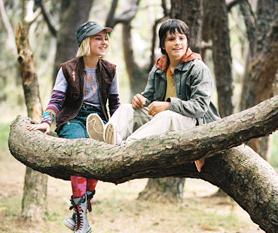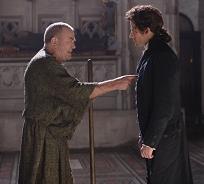 I walked into the theater with great trepidation to see Walt Disney’s film adaptation of Katherine Paterson’s Newbery Award-winning “Bridge to Terabithia,” a story about a friendship between a boy and a girl, Jess and Leslie. From the look of the commercials, I feared that this beloved novel from my youth–so widely read still today in schools, touted by children’s librarians and teachers everywhere–had been Disney-fied into a sugar-coated fairytale, complete with dancing creatures and perhaps even a song or two. Advertisements for the film are a barrage of fantastical creatures–inventions that indeed are part of Jess’s and Leslie’s imaginative play in the novel–but which never come to life in the way that C.S. Lewis’s Pevensie children experience Narnia as a parallel world, but a also a real one in “The Chronicles of Narnia.”
I walked into the theater with great trepidation to see Walt Disney’s film adaptation of Katherine Paterson’s Newbery Award-winning “Bridge to Terabithia,” a story about a friendship between a boy and a girl, Jess and Leslie. From the look of the commercials, I feared that this beloved novel from my youth–so widely read still today in schools, touted by children’s librarians and teachers everywhere–had been Disney-fied into a sugar-coated fairytale, complete with dancing creatures and perhaps even a song or two. Advertisements for the film are a barrage of fantastical creatures–inventions that indeed are part of Jess’s and Leslie’s imaginative play in the novel–but which never come to life in the way that C.S. Lewis’s Pevensie children experience Narnia as a parallel world, but a also a real one in “The Chronicles of Narnia.”
Basically, I worried that Disney had turned “Bridge to Terabithia” into a fantasy film.
Well, they did not, I am pleasantly surprised to report. In fact, the movie follows Paterson’s novel so faithfully that much of the characters’ dialogue is taken straight out of the novel–including the bits when Jess, Leslie, and Jess’s younger sister May Belle talk about whether Leslie will go to hell because she doesn’t believe in the Bible:
“You gotta believe the Bible, Leslie,” says May Belle as they bounce in the back of the family pickup truck on their way back from Leslie’s first time ever at a church. When Leslie asks why believing in the Bible is so important, little May Belle explains,” ‘Cause if you don’t believe the Bible, God’ll damn you to hell when you die.” Jess adds his words of agreement about the matter, though rather reluctantly.
And as the film doesn’t shrink from exploring the religious themes in the novel, neither does it hold back from showcasing what once was typical in the lives of children, but grows scarcer in our world of scheduled, organized, parent-supervised and parent-led play: a boy and a girl who find amusement not on the soccer field or with an X-Box or through a play-date, but by running off into the woods each day after school, rain or shine. The friendship between Leslie and Jess is built on the simplicity of finding a rope swing tied to a tree, building a fort in the woods, and letting their imaginations run wild to this place called Terabithia, which Leslie invents through the sounds of the forest, the birds in the trees, the rustling of the wind–all of which become part of their make-believe after school world where they seek shelter from family troubles and school bullies among other challenges related to growing up.
As I sat in the theater, I couldn’t help remembering my own childhood, which was filled with endless days where I would run off with the rest of the neighborhood kids to build forts in the woods with old boards, blankets, and whatever materials we could find, only coming home when my Mom yelled out that it was time for lunch or dinner. And I couldn’t help thinking about how this kind of play seems to be a thing of the past, given parents’ fears about children being out of sight, and parents’ desires for kids to constantly be in supervised learning environments. I wondered if “Bridge to Terabithia” might seem to some kids like a fantasy film, because imagined, unsupervised play like that of Jess and Leslie is becoming a thing of the past.
But I also worried–given the novel and the film’s turning point and center (which I will not reveal here)–if, while on the one hand, this story opens the eyes of children and parents about a special kind of childhood play, at the same time it may serve as a cautionary tale against allowing children and their imaginations such freedoms.
A word of warning to parents: Though commercials make this film look like a “Narnia” movie of sorts, I must admit my intense surprise to walk into the theater and see it filled with parents with children as young as four. This is certainly a movie parents should see with their children, but it is a story for older children, not nursery school kids and kindergartners. At the dark, intense point on which the story turns, it was clear from the loud gasps among virtually all the parents in the theater that they were unfamiliar with the major theme of Paterson’s novel, and the reason why she wrote the story.
That said, if you were worried that Disney had sugar-coated this classic story, fear not. This film is a faithful tribute to one of the most beloved stories the prolific Katherine Paterson has left to children, old and young.


